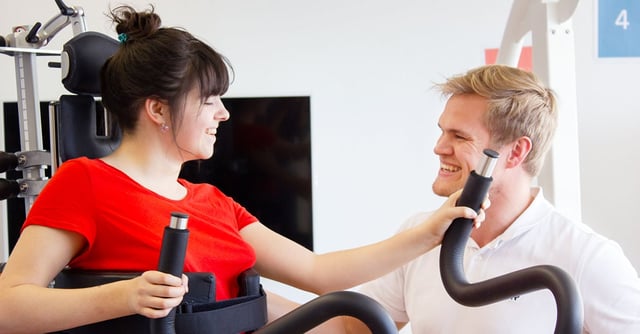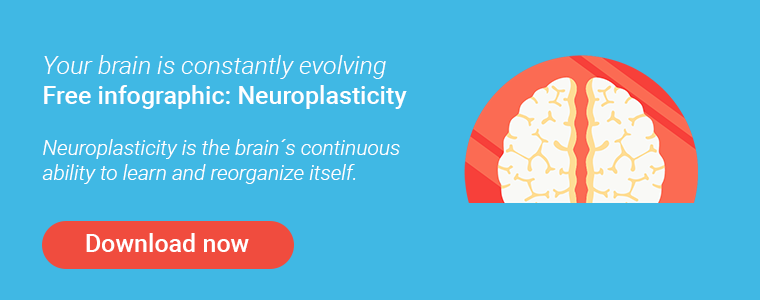
17-Oct-2022Stroke recovery: The value of physical therapy in rehabilitation

Back to Blog Overview
Learn how rehabilitation after stroke can improve functional performance. Julian Breuer, Head Physio at NiB Köln shares his knowledge and experience with us in this article.
NiB Köln is one of Germany’s premier out-patient rehabilitation centres, serving patients who’ve suffered stroke, spinal cord injury, Multiple Sclerosis, disorders and diseases. They treat around 700 patients during a year, and around 65% of these have suffered a stroke.
In Germany, neurological rehabilitation after stroke is divided into the phases A, B, C, and D. Phase A is carried out within the Intensive Care Unit at hospitals. Then the patients move to phase B – early rehabilitation on an inpatient basis. Both phase C and D are carried out on an out-patient basis. This means that the patients are living at home and attending a rehabilitation program at a rehabilitation centre during the day, 3 to 5 days a week.
NiB provide intensive rehabilitation treatment for phase D stroke patients, from severely affected patients to those with moderate impairments.
We have asked Julian Breuer to give insight to:
- How he plans a typical rehab program for stroke patients
- How the program looks
- Example of technical equipment he uses
- What the outcome measures are
- What you as a stroke patient can anticipate from rehabilitation
Intensive training is crucial in stroke recovery
Recovery depends very much on a supervised and properly dosed rehabilitation program. However, the stroke recovery process looks different for everyone because every stroke is different. “Some patients who come to our rehabilitation centre can walk independently but may have difficulties with fine motor skills and speech. Others may have just learned to walk again and need support, while some are not able to stand or walk at all and are dependent on wheelchair”, Julian tells.
While the aftermath of stroke can be devastating for some, rehabilitation can help you regain your independence. To keep up the momentum you gain during the first phases of inpatient rehabilitation, you should continue with intensive training together with different specialists. Neurological rehabilitation at NiB in Köln encompasses a variety of professions such as doctors, physiotherapist, speech therapist and occupational therapist - all in one location.
Julian Breuer, the head physio at NiB, is a physiotherapist trained to improve motor function, lessen discomfort, re-establish skills and prevent dysfunction. He is also very creative in finding new and motivational ways of performing exercises. The goal is to encourage patients to live active lives.
I try to reveal what each unique patient enjoyed doing before the stroke, and if possible, implement this activity in combination with therapy. For instance, playing tennis during walking therapy with a former tennis player. – Julian explains.
However, before he and his stroke patients get there, he assesses and addresses each person individually.
It all starts with a patient-specific evaluation
A physiotherapist team at NiB assesses and addresses various conditions such as:
- Muscle weakness
- Decreased mobility
- Decreased endurance
- Difficulty walking
- Falls risk and fear of falling
- Pain
- Loss or limitation in function
As part of the assessment they run pre-tests such as functional gait assessment, “Timed Up and Go test” and “6-minute walk test”. The team then develops the most appropriate treatment plan to achieve optimal outcomes. After a period, they will re-assess the patient to measure if the patient is progressing and adapt the program in accordingly.
Basic transfer and gait safety as outcome measures
Stroke survivors often develop a “chronic sedentary lifestyle”. Exercise and activity programs not only reduce risk of subsequent stroke, but also strengthen independent living abilities, maintain, or improve cognition, and reduce depression.
The treatment plan objectives are very often addressing the ability to perform basic transfer and to walk safely. This will in turn facilitate increased independence during activities of daily living.
“We work to improve mobility and balance to enable walking and to decrease the risk of falls. The treatment plan is also focused on improved muscle strength, joint stability, flexibility, and circulation. Which, in turn, can reduce pain and improve quality of life” explains Julian.
How does the treatment program look?
The amount of rehabilitation time you are entitled to is depending on your health insurance. It decides how many days a week you can attend with specialists at a rehabilitation centre.
“Usually people come here for rehabilitation 3-5 days a week. After a period of 15 days we do an evaluation to determine whether the program should be extended. A typical stroke patient stays in the treatment program for around 2 months” Julian says.
“Severely affected patients sitting in a wheelchair typically get three hours of movement training per day. This is broken down to one hour of hands on physiotherapy, one to two hours of walking therapy where different types of technical equipment and robotics are used to facilitate walking. The rest of the day includes group training, occupational therapy, speech training and neuropsychology” he continues.
NiB Köln is a leading clinic in innovative rehabilitation therapy offering technical, robotic treatment devices such as the Lokomat and the Innowalk Pro. Utilizing these technologies expands the treatment opportunities and improves the safety for both the patients and employees.
Exercise in the Innowalk Pro after a stroke
The Innowalk Pro provides patients high-intensity mobilization of the whole body. “We typically use this device for the most affected patients, not able to stand and walk by themselves. But the patients with spasticity in their arms, having difficulties while walking, also start the rehabilitation in the Innowalk Pro” says Julian.
Spasticity and reduced range of motion create stress and concerns for stroke patients. They are afraid to fall or to move with pain. “Patients sitting in wheelchairs for example have limited range of movement and are very happy when they realise that they can gradually come up in an upright position with weight-bearing safely and without pain” Julian tells.

”A session in the Innowalk Pro takes between 30-60 minutes, and the patients experience that their muscle tone is regulated, they relax – and all this makes this movement training a great preparation for other therapies.” Julian continues.
“We experience that the patients stand and walk better after a session in the Innowalk Pro.
The patients really enjoy the Innowalk Pro training saying it feels so normal, almost like being in an ordinary cross trainer – they start feeling their body again, respiration rate increases and the ability to use their voice improves.
Last week a stroke patient found our rehabilitation centre online, and he wants to enter a stroke treatment program at NiB Köln, 200 km away from his home. Driving here 5 times a week was not considered a problem” Julian tells, which must prove that the benefits outweigh the inconvenience.
Training after rehabilitation
After a rehabilitation period, about 50 % the NiB patients come back in by prescription to get physiotherapy, occupational therapy, and fitness training, often in groups. This extended program is typically 3 times a week.
“My personal opinion is that the individual, intensive training they get during rehabilitation should be continued since high frequency is what it takes to maintain their improvements in the long run” Julian says.
Your rights for rehabilitation after a stroke are different from country to country. In Germany you have a right for rehabilitation if there are potential to improve function. You also have a right to choose where to get the rehabilitation. If you have chronical problems following the stroke you have the right to continue with rehabilitation every 4th year.
Here are a few links to websites with lots of resources if you or someone close to you have suffered a stroke. www.stroke.org.uk/life-after-stroke, www.differentstrokes.co.uk, www.headway.org.uk
About NiB Köln
NiB Köln was established in 1998 and is run by Jens Rodenberg and his wife, medical director Dr. med. Anuschka Rodenberg.
Their broad expertise makes it possible to treat about 700 different rehabilitation patients every year.
- Employees: The centre employs both occupational therapists, physiotherapists, and medical doctors.
- Location: Köln, Germany
- Specialist expertise: Their expertise span from patients diagnosed with multiple sclerosis and Parkinson, to spinal cord injuries, cerebral palsy and stroke.
NiB Köln is a Partner Centre of Made for Movement, which means that they facilitate Innowalk Pro try-outs and provide prescription for the Innowalk for home use.
Can the brain repair itself after a stroke?
This easy to understand video about neuroplasticity explains how the brain can repair itself.

The author worked as Head of Marketing for Made for Movement for 7 years before she pursued other adventures in her own company. Trine Roald has over 20 years of international experience within a variety of industries. As Head of Marketing for Made for Movement she was passionate about communicating stories and know-how featuring possibilities for improving the quality of life among people with severe disabilities.


